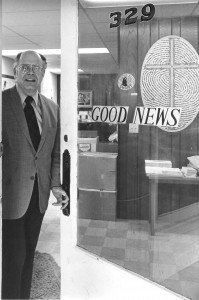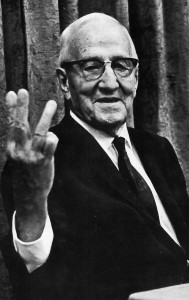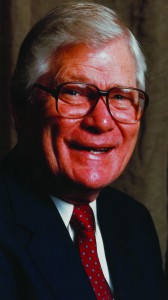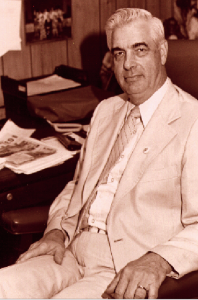Archive: The Making of a Movement
By James V. Heidinger II-
The Rev. Charles W. Keysor, a Methodist pastor in Elgin, Illinois, published the first issue of a digest-size magazine for Methodist evangelicals out of the basement of his parsonage in 1967. At the suggestion of his wife, Marge, he called it Good News.
It had all begun a year earlier when James Wall, then editor of the Methodist minister’s magazine Christian Advocate, asked Chuck, “Why don’t you write an article for us describing the central beliefs and convictions of this part [evangelical wing] of our church?”
Chuck’s article, “Methodism’s Silent Minority” was published in the July 14, 1966 issue of the Christian Advocate, where he identified the major evangelical convictions (see original article on p. 12).
To his amazement Keysor received over 200 letters and phone calls in response to his article, most of them coming from Methodist pastors! Two themes surfaced in the responses: first, “I thought I was the only one left in the church who believes these things,” and second, “I feel so alone — so cut off from the leadership of my church.”
As he prayed about the letters and phone calls, Chuck felt he must do something. Having been a journalist prior to entering the ministry, he decided to launch a magazine which affirmed the evangelical message of the Wesleys and Francis Asbury. Good News magazine was born.
Responses to the first issue were much like today. One disgruntled Methodist in Alabama wrote, “Your magazine is JUNK!” But Dr. Carl F. H. Henry, founding editor of the evangelical journal Christianity Today, wrote, “A mighty fine beginning — congratulations!”
Rallying renewal groups: Seeing the immediate surge of interest in his magazine, Keysor chose 12 Methodists to serve as board members, and the Good News effort became incorporated as “A Forum for Scriptural Christianity.” The board’s first meeting was in May of 1967, only two months after the appearance of the first issue of the magazine.
Good News was a breath of fresh air for Methodists seeking spiritual renewal, quickly becoming their rallying point. Pastors and laity began organizing clusters of like-minded Methodists who came out of a felt need for fellowship, support, encouragement, and prayer. Soon, they began to map strategies for increasing evangelicalism within their annual conferences. Today, renewal groups exist in many United Methodist annual conferences, forming an extensive grassroots network for evangelical advocacy, fellowship, and prayer support.
Convo fellowship: The Good News board soon felt a need to sponsor a national gathering to help unify Methodist evangelicals. The Rev. Mike Walker, a pastor from Texas and the youngest member of the fledgling board, headed up plans for the first national convocation held in Dallas in August 1970. To everyone’s amazement, a whopping 1,600 United Methodists registered, coming from coast to coast! The Holy Spirit drew people together in a remarkable way.
Emotion and excitement filled the air as participants discovered other like-minded Methodists. Tears streamed down the faces of worshippers as they saw the evening crowds swell to nearly 3,000 persons jammed into the Adolphus Hotel ballroom. Folks heard luminaries such as author and missionary statesman Dr. E. Stanley Jones (Christian Ashram), Bishop Gerald Kennedy (Southern California), Dr. Frank B. Stanger (Asbury Theological Seminary), Dr. Dennis F. Kinlaw (Asbury College), Dr. K. Morgan Edwards (Claremont School of Theology), Dr. Claude Thompson (Candler School of Theology), the Rev. Tom Skinner (author and evangelist from Harlem), the Rev. Howard Ball (Campus Crusade for Christ), the Rev. Dr. Akbar Abdul-Haqq (evangelist with the Billy Graham Association), the Rev. Dr. Ira Gallaway (district superintendent of Fort Worth), the Rev. C. Philip Hinerman (Park Avenue United Methodist Church in Minneapolis), and the Rev. Dr. Les Woodson (Elizabethtown, Kentucky).
In bringing greetings to the assembly, a message from evangelist Billy Graham stated: “Wish I could be with you for this momentous and historic conference. Methodism was born and it grew through revival and evangelism. It is my prayer that the United Methodist Church will have a spiritual renewal and help lead our nation in the spiritual revival that we so desperately need. May God bless you all.”
Twentieth century United Methodism was marked for renewal. Discouraged United Methodists received hope that they weren’t alone in their evangelical concerns. And most importantly, they began to dream of a new day of revival and renewal in their church. For 30 years following the Dallas Convocation, Good News sponsored a national convocation nearly every summer. United Methodists came for fellowship, inspiration, and instruction.
Improving Sunday school literature: One of the earliest concerns of the fledgling Good News movement was the need to improve dismal denominational Sunday school literature. Evangelicals were frustrated, but hardly knew where to begin to bring about change.
In 1968 Good News carried a stinging evaluation of Methodism’s new adult curriculum. One reviewer wrote, “What is missing here … is a particular and sustained biblical theology.” This reviewer looked in vain for any word about “salvation, any good news about the atonement of Jesus Christ, or any hint about the possibility of spiritual new birth….”
The next year a Good News team met for the first of many dialogues with the church’s curriculum editors and officials. The denominational leaders responded with obvious impatience and condescension toward evangelical concerns. One bishop informed the Good News delegation that they must realize that all contemporary scholars supported the Bultmannian notion that much of the Bible is myth. That was indicative of the gulf that existed between grassroots members and many in positions of national leadership.
Nevertheless, dialogue had begun. The United Methodist Publishing House gradually became more aware of its responsibility to serve the whole church, including the evangelicals. In 1975, Good News published its first edition of We Believe, a confirmation series for junior high youth. Pastors dissatisfied with United Methodist materials received it enthusiastically. It remains a widely-used confirmation curriculum yet today.
A 1985 evaluation of denominational curriculum revealed improvement in our church school literature. In addition, the Disciple Bible Study program has found a warm welcome in the church, as has more recently Christian Believer, a similarly-packaged in-depth study of Christian doctrine, a resource from the United Methodist Publishing House (UMPH) which is doctrinally sound.
The problem evangelicals had with church school curriculum was its lack of consistency. For adults especially, one quarter’s materials might be sound while the
next were disappointingly weak, which is the problem with materials that are published for a broad sweep of theological positions. This inconsistency, among other things, was the impetus that led Good News to begin publishing its Wesleyan and evangelical Bristol Bible Curriculum for many years, as well as Trinity Bible Studies and We Believe confirmation material.
Through its book and curriculum publishing endeavor, Good News exercised its heartfelt desire to provide theologically orthodox and biblically-based resources to United Methodists. In addition to the Wesleyan curriculum, the initial book titles included Basic United Methodist Beliefs written by a team of evangelical scholars and theologians and The Problem with Pluralism: Recovering United Methodist Identity written by Dr. Jerry Walls, noted philosopher and theologian.
Until most recently, both the We Believe confirmation materials and the Bristol Bible Curriculum were published by the independent, for-profit publisher, Bristol House, Ltd., headquartered in Georgia. (Good News sold its publishing ministry in 1991 to a small group of Good News supporters – that included Dr. John and Helen Rhea Stumbo, a lifetime Good News board member and current chairperson of our board of directors – who formed Bristol House, Ltd. in order to continue the publishing endeavor.)
Doctrinal doldrums: From the start, Good News’ primary concern has been theological. Born in an era when church radicals were demanding “Let the world set the agenda for the church,” we were convinced that the biblical agenda was languishing from both neglect and from theological revisionism.
Adding to United Methodism’s already-existing theological malaise, the 1972 General Conference adopted a new doctrinal statement of “theological pluralism.” While pluralism may have been included to express some of the legitimate diversity found within the parameters of historic Christianity, it was interpreted by many to mean United Methodism offered members a proliferation of theological views, many of which far exceeded the boundaries of sound biblical doctrine.
A young pastor friend of mine was distressed because a United Methodist seminary professor had denied the bodily resurrection of our Lord. He expressed his concern about the matter in his church newsletter. His district superintendent admonished him, saying, “Ed, you must remember that you are in a church that embraces theological pluralism.” For that superintendent, theological pluralism meant that some may affirm the bodily resurrection of Christ and some may not.
In 1974, Good News authorized a “Theology and Doctrine Task Force,” headed by Paul Mickey, who at that time was associate professor of pastoral theology at Duke University’s Divinity School. The task force was charged with preparing a fresh, new statement of “Scriptural Christianity” which would remain faithful to both the Methodist and Evangelical United Brethren traditions. In addition to Mickey, the committee included myself, Charles Keysor, Frank B. Stanger, Dennis F. Kinlaw, Robert Stamps, and Lawrence Souder.
In 1975, the Task Force presented its statement to the Good News board and it was adopted at its summer meeting at Lake Junaluska. It thus became known as “The Junaluska Affirmation.” To its credit, The United Methodist Reporter published the affirmation in full and provided commentary. Dr. Albert Outler, United Methodism’s eminent theologian, praised Good News at the time for being perhaps the only group within the church to respond to his challenge for United Methodists to “do theology.”
Theological issues were always top drawer for Good News. Our questions and frequent criticism of theological pluralism played a major role in the 1984 General Conference decision to develop a new doctrinal statement for the church. The theological commission, authorized by that General Conference and chaired by Bishop Earl G. Hunt Jr., brought a new and much improved theological statement which was adopted overwhelmingly by the 1988 General Conference. It cited “the primacy of Scripture” as the new guiding principle for doing theology.
The term “theological pluralism” was purposefully and conspicuously omitted from the new statement. Some today still try to resuscitate “theological pluralism” under the guise of diversity. However, United Methodism has its clearly articulated doctrinal standards which are protected by Restrictive Rule in the Book of Discipline (Par. 17. Article I).
The seminary challenge: Good News has long been troubled over the liberal domination of theological education. Across the years, evangelicals at our United Methodist seminaries have consistently reported unfair caricaturing, ridicule, and intolerance toward their orthodox, biblical beliefs. They also have cited a troubling dearth of evangelical faculty at our seminaries.
In 1975, United Methodist evangelist Ed Robb Jr., in a fiery address at Good News’ summer convocation, called upon the church to restore Wesleyan doctrine to our United Methodist seminaries. Institutional leaders fumed and seminary professors fussed about his challenge. One could hear the murmurs echoing from their hallowed halls: “How dare he be so critical!”
However, Robb’s hard-hitting address led to a new friendship with Dr. Outler who taught at Perkins School of Theology in Dallas. Together, with help from others, they formed A Foundation for Theological Education (AFTE). To date, more than 160 evangelical scholars, called John Wesley Fellows, have participated in the scholarship program, receiving grants to seek their PhDs with plans to return to teach at our United Methodist colleges and seminaries.
In 1976, Good News also began publishing Catalyst, the free newsletter sent to all United Methodist seminarians, with the goal of making them aware of evangelical scholarly resources which they did not always have in their liberal seminary setting. The Rev. Mike Walker, the board member who organized the first Good News convocation, has coordinated the editing and mailing of Catalyst from its inception. (It continues today under the auspices of AFTE.)
In 1977, Good News sent teams to nearly all United Methodist-related seminaries, engaging them in dialogue and urging them toward greater openness to evangelical faculty, course materials, and library resources.
Missions derailed: In 1974, United Methodist evangelicals from 23 states gathered in Dallas to discuss their concerns with the church’s world missions program. Those gathered criticized the declining number of overseas missionaries, the mission board’s preoccupation with social and political matters, and its lack of concern for matters of faith — including conversion and the planting of new churches.
The group formed the Evangelical Missions Council (EMC) which several years later would become an arm of Good News. Dr. David A. Seamands, Good News board member and former missionary to India, was named EMC’s first chairman. Conversations with the General Board of Global Ministries (GBGM) continued. However, after no less than 22 “dialogues” over an 11-year period between Good News and GBGM, Seamands, and others learned that “the unfortunate gulf separating us from the GBGM policymakers was wide and deep.”
For eight years, the Rev. Virgil Maybray, a highly-respected clergy member of the Western Pennsylvania Annual Conference, served as full-time executive secretary of Good News’ EMC effort, spending most of his time speaking in, and consulting with, local churches about expanding their missions programs. During that time, Virgil ministered in more than 350 UM churches in 35 states, raising millions of dollars for missions, with more than $1 million channeled directly through GBGM’s Advance Special Programs.
In 1983, when evangelical discontent peaked upon learning about the proposed new leadership of the World Division of GBGM, 29 large-church pastors and 4 missions professors (all United Methodist) met in St. Louis to form a “supplemental” missions sending agency. It was to be called The Mission Society for United Methodists. It opened its doors for ministry in February of 1984 and began helping United Methodists get to the mission field. Today, with headquarters in Norcross, Georgia, and now known as simply TMS Global, the sending agency now has 180 persons in ministry (full-time, standard support) in 35 countries.
Legislative landmarks: United Methodist evangelicals and traditionalists have struggled with how to respond to the church’s liberal theologies and programs. They could ignore them, find another church, or use their influence for positive change. Good News opted for the latter.
At the 1972 General Conference in Atlanta, Good News launched its first involvement in the legislative process. Board members Bob Sprinkle and Helen Rhea Stumbo prepared and distributed ten petitions and four resolutions. They also cranked out occasional newsletters. Although the 1972 conference was a disaster, approving abortion and adopting the statement on theological pluralism, Good News had thrown its hat in the ring.
The 1976 General Conference brought a stronger Good News showing with the additional help of the Revs. Robert Snyder and John Grenfell. By 1980, Good
News had launched its first full-orbed effort, led by Don and Virginia Shell. They continued leading Good News’ legislative strategy program until 1992, when they turned the leadership over to Lynda and Scott Field, a former Good News board chair and United Methodist clergy person in the Northern Illinois Annual Conference. They gave extraordinary leadership to the Good News General Conference effort from 1996 through 2004. The legistlative baton for General Conference has been handed over to the Rev. Thomas Lambrecht, the vice president of Good News, and to his capable leadership of the Reform and Renewal Coalition.
The Good News effort has worked behind the scenes in annual conferences to get evangelical and traditional delegates elected as General Conference and Jurisdictional delegates, well-crafted petitions channeled properly, and a series of position papers published which articulate our stand on major issues.
The nearly two weeks Good News spends on site at General Conference with our 40-person team is the culmination of more than two years of careful preparation. As a result of Good News’ field work and legislative training efforts, many more United Methodist evangelicals became involved in the legislative process.
Traditionalist believers were encouraged by the efforts of concerned denominational leaders to formulate pre-General Conference activity such as the 1988 “Houston Declaration” and the 1992 “Memphis Declaration.” Both of these initiatives were spearheaded by the leadership of what is now known as the Confessing Movement within the United Methodist Church — which included Bishop William Cannon and prominent pastoral leaders such as James B. Buskirk, Maxie D. Dunnam, Ira Gallaway, John Ed Mathison, Thomas C. Oden, William Bouknight, and William H. Hinson. The grassroots efforts noted above reflected the growing conviction that evangelicals must engage in the legislative process to make their voices heard if the church is ever to experience renewal and reform.
Proliferation of evangelical voices: It is amazing that at one time – 50 years ago – there were no groups or publications that spoke on behalf of United Methodism’s evangelical or conservative constituency. That, no doubt, helps explain the immediate flood of responses to Chuck Keysor’s inaugural article, “Methodism’s Silent Minority.”
It’s a different world today and The United Methodist Church is not the same church. Think of the organizations that didn’t exist in 1966: Good News; United Methodist Action, a division of The Institute on Religion and Democracy; The Confessing Movement, A Foundation for Theological Education, The Mission Society, Transforming Congregations, Lifewatch (the Taskforce of United Methodists on Abortion and Sexuality), the Renew Network, Seedbed, and Concerned Methodists.
We should also note the important contribution of several groups affiliated with the General Board of Discipleship, including the Council on Evangelism, the Foundation for Evangelism, the National Association of UM Evangelists, and Aldersgate Renewal Ministries. The above groups have been faithful voices on behalf of our Wesleyan theological heritage.
All of these groups, of course, have their own histories and purposes. They do not walk in lockstep, to be sure. But let’s not miss the significance of their existence. The voices of United Methodist evangelicals and traditionalists are finally being heard. Thousands of United Methodists have found avenues for evangelical ministry as well as ways to effectively address the spiritual, moral, theological, and social issues that exist in our church.
Emerging new spirit: The various evangelical groups noted above are a part of something new that is emerging within the United Methodist Church. I would call this new surge a growing expectation that the church be faithful to its historic message. More and more United Methodists have grown weary of theological revisionism and doctrinal fads; weary of those who would use the church in order to advance an ideological agenda. It is time for all of our United Methodist leaders to embrace, believe, and teach the historic doctrines of our Wesleyan tradition.
We are especially excited about the proposal for starting new congregations all across the country. Evangelism has always been a passion for the Good News constituency. For many years, Good News magazine was a promotional partner with The Alpha Course. By their account, our involvement was a major factor in Alpha being used in more United Methodist churches than any other denomination in America.
Cry for leadership: When United Methodists feel compelled to form alternative groups within the church and gather at their own expense to issue declarations to the church – as they did at Houston and Memphis and, most recently in, Chicago – what you have is a plea for godly leadership. We look hopefully to our bishops who are charged with the teaching and overseeing function in the church. Our bishops, according to Paul, “must hold firmly to the trustworthy message as it has been taught,” so they can “encourage others by sound doctrine and refute those who oppose it” (Titus 1:9).
It is easy for evangelicals to grow weary in the struggle for renewal. Some who do will often say, “The struggle is a distraction from the real ministry of the church.” But Presbyterian clergywoman, the Rev. Sue Cyre, former editor of the journal Theology Matters, has written an apt reply: “The battle over truth and falsehood is the real ministry of the church,” writes Cyre. “Everywhere the church goes, it is to proclaim the truth of the Gospel, but it is always against a backdrop of some false beliefs.”
New day for United Methodism? So perhaps a new atmosphere is emerging within the church. Granted, we still face serious problems, but there is much reason for hope.
As I have stated during my time as the president of Good News, evangelicals believe the church has been entrusted with a divinely-revealed plan of redemption. This message is set forth clearly in the Word of God. This fact automatically establishes the relevance of the Christian message. We must resist attempts to impose other standards of relevance upon it. The biblical message, proclaimed in the power of the Holy Spirit, will still bear fruit today. This trustworthy message will revitalize and renew United Methodism and enable us to share in the evangelical awakening that already is moving across our land and world. When our pulpits are alive again with the faithful proclamation of the Word of God, we can be sure the Lord will once again add daily to the United Methodist Church “those who are being saved.”
James V. Heidinger II is the publisher and president emeritus of Good News. Dr. Heidinger, a clergy member of the East Ohio Annual Conference, led Good News for 28 years until his retirement in 2009. He is the author of several books, including the forthcoming The Rise of Theological Liberalism and the Decline of American Methodism (Seedbed).










As Wesley might have remarked, we don’t make disciples for Jesus by stuffing doctrines and discipline down people’s throats, or by offering some kind of ‘cheap grace’ prescription. The development of the Reign of God is largely about the practice of love with justice, giving people the vision and the means to see it from their own context, not prefabricated by rich white men in the South of the USA.